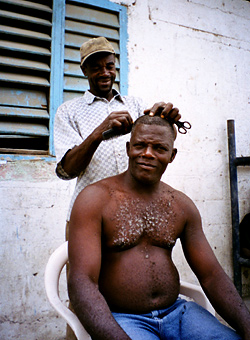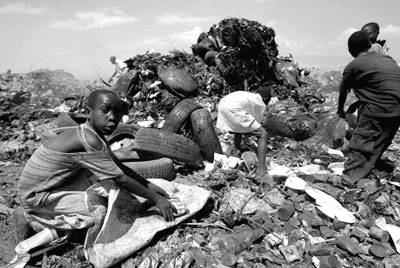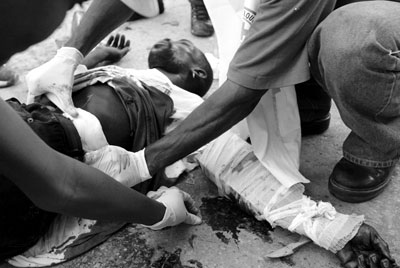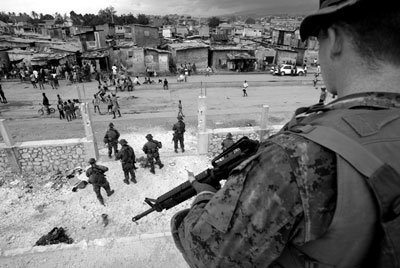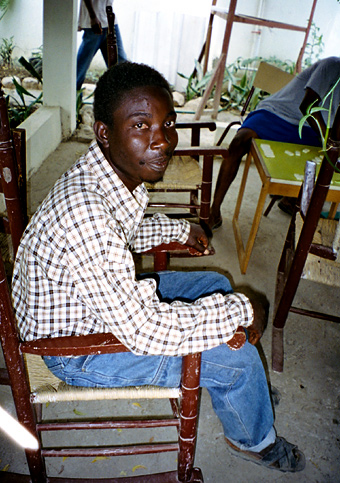
Sonia, a 25-year-old convert to Islam, was born in France but says that many French perceive her as a foreigner. Discrimination has only gotten worse since 9/11,” she says. (photo by Tanguy Kouessan)
In a scruffy classroom at the University of Paris X at Nanterre, in a suburb outside Paris, a group of academics, journalists, and activists of all stripes gathered in March to hash out the “crisis”: what to do about the Islamic veil in French schools. A small group of college-aged women at the back of the room listened quietly until a man at the front pointed in their direction. Three of the women wore a hijab covering their hair, forehead, and neck. Together, they had been half-heartedly working on a crossword puzzle, but now they were on the spot.
“When I look at these girls,” the man said, “I can’t help but think that they’ve been branded ‘hallal’ — like a piece of meat — by an Islamist patriarchy. I fled Algeria for France to get away from this sort of intolerance, and now it’s infiltrating the Republic!”
One of them put down the crossword. “I’ve been wearing this veil since I was twelve, and it was my personal decision to put it on.” she said. “It’s not a question of submission to men, but of religious expression.”
Her voice started to shake, and then, fighting back tears, she said, “I’m a French citizen. I was born here. I thought the French Revolution was fought for freedom, but here we are being marginalized and humiliated once again. Stop insulting our intelligence! Stop treating us like imbeciles!”
“Islamism is a wart on the face of this country.” responded the man, Derri Berkani, a journalist, filmmaker, and practicing Muslim. Berkani said he had heard enough about the symbolism of the voile. “The veil is not a religious issue, but a political one, so I could give a damn about their cause,” he said. “There’s nothing in the Koran that obliges a woman to wear a veil.”
The packed lecture hall erupted in fragmented arguments and debates that exceeded my level of French. A literature professor who called himself a communist extolled the secular values of the Republic as a counterweight to religious extremism and American imperialism, while a young Moroccan proclaimed that only Islam could combat the moral decline of the West. Just when the room verged on complete anarchy, Nelcya Delanoë, a professor in the Anglo American Studies department at Nanterre, called for order, but the women in the back were still seething.
The veiled woman who had spoken earlier, a 23-year-old political science student named Khalidja (students quoted in this article requested that only their first names be used), asked Delanoë if she could respond to some of the comments, but slipped into the informal “tu,” rather than the more formal “vous,” in her request.
“You will not address me as ‘tu,’ young lady,” Delanoë chided. “You will show me some respect!”
“Only when you show us some respect,” Khalidja replied.
When I found Khalidja after the meeting, she was exasperated and enraged. Surrounded by a group of friends chatting away on cell phones, some wearing veils, some not, she seemed to embody all the contradictions of a reinvigorated Islam in secular France: She wore stylish sneakers poking out from under an austere robe and sprinkled her French with a variety of curse words. Khalidja had almost finished the equivalent of a master’s degree and would soon start looking for a job, probably as a government functionary.
I asked her if she would have to take off the veil if she worked in government.
“I will leave France before I’m forced to take off my veil. I’m French and I don’t see a contradiction between my country and my religion, but I’ll move to the U.S. if it comes to that,” she said.
I asked her if she thought Islamophobia — a popular term in the French media — is a problem in the United States as well. Like almost every French person I had met, she despised President George W. Bush and prefaced her answer with a denunciation of the war in Iraq and the current administration’s Middle East policies.
“But do you think the United States is more tolerant?” I asked.
“Yes,” she said. “Religion is important in the States. Here if you have any sort of religious belief people think you’re a barbarian or just plain retarded.”

The Paris Mosque is the spiritual center of France’s “second religion,” Islam. Many French now question whether the growing popularity of Islam is compatible with the country’s strict secular traditions. (photo by Tanguy Kouessan)
Lost in translation
Like the United States, France constantly wrings its hands over the separation of church and state, although the rebirth of Islam in the marginalized banlieues — dreary, crime-ridden suburbs — poses a problem for France which the United States has yet to face on the same scale. It is undoubtedly a vast, complex problem that has much to do with France’s troubled colonial history as it does with religious extremism. Nevertheless, the veil has become the flashpoint for almost every discussion about immigration, Islam, terrorism, or French identity since last December when a 20-member commission, assembled by French President Jacques Chirac, named the Stasi Commission (after a former education secretary), recommended a ban on all conspicuous religious symbols in state-run spaces. In addition to the ban on the veil, the commission called for a ban on large crosses and yarmulkes, the Jewish skullcaps, as well as two new official days off for Yom Kippur and Aid-e l-Kebir as tokens of acceptance of non-Catholic holidays in a country where Ascension Day is still a paid holiday.
By all accounts, a majority of the French supported the ban: in a poll taken in early February 2004, 57 percent said that conspicuous religious symbols were “a threat to national cohesion” and 69 percent said they favored banning the headscarf from public schools. The law sailed through the National Assembly shortly after the poll was taken, with little opposition. Although Chirac signed the bill into law in February, it took the French Council on Education until May to work out the finer details, like whether bandanas will be prohibited (it will depend on the point of view of individual principals). The law is set to go into effect at the start of the next school year. Among the few politicians to criticize the law was France’s new economics minister and fastest rising political star, Nicolas Sarkozy, who went so far as to call the ban “secularist fundamentalism.”
To really understand why the Islamic headscarf has become so controversial in France, one must try to understand two words that are often bandied about in this debate and are not easy to translate into English: laïcité and communautarisme. The first term is often translated in the American press as “secularism,” as if it simply designated the separation of church and state, a familiar issue to Americans. In reality, laïcité implies a set of political and cultural values, that, in a way, have become a pseudo-religion of the state.
As one member of Chirac’s Stasi Commission, philosopher Henri Peña-Ruiz, put it in Le Monde Diplomatique recently, “laïcité only favors what is in the common interest [of the Republic]. With moral and intellectual autonomy, it promotes the freedom of conscience and the total equality of rights without regard to sex, [ethnic] origin, or spiritual conviction.” Because of laïcité, he continued, “tomorrow, thousands of young women will be recognized by the Republic as having preserved their right to bare their heads at school and sit next to boys who have the same status as them.”
Communautarisme, on the other hand, roughly means “multiculturalism,” although its connotations are almost entirely negative. Communautarisme, to the French, is what happens when you let immigrants form their own communities, speak their own languages, and practice their own religions. Consequently, France becomes less “French” and more open to foreign values and cultural practices.
To be sure, there are real dangers associated with communautarisme — such as support for female circumcision in Malian or Senegalese communities or acceptance of stoning women who are accused of adultery by certain Muslim imams — but it’s hard to distinguish when legitimate concerns about human rights cross over into racist notions about cultural superiority.
The controversy surrounding the Islamic veil actually dates back to at least 1989, when the Council of State, one of France’s high courts, ruled that religious symbols that “constitute an act of intimidation, provocation, proselytizing or propaganda” could not be worn in public schools. Under this decision, individual schools were left to determine what was a provocation and what was simply a personal expression of faith. Often, this came down to a judgment call by individual teachers and principals.
“I had girls with half-scarves and full-on veils,” remembers Isabelle, a middle-aged English teacher in a poor suburb northeast of Paris who did not want her last name used. “You couldn’t tell the difference between religious proselytism and fashion. That’s why I supported Chirac’s law at first: It backed teachers up so that it wasn’t just us against the students and their parents.”
Now, however, some of the same teachers who favored the ban are rethinking their positions. “It’s going to be impossible to enforce,” Isabelle predicts. “And the Muslim girls who refuse to take off their veils — where are they going to go?”
Khalidja, the political science student, says she favors opening up more Muslim private schools if France won’t compromise on the veil issue. So far, however, there is only one Muslim school in the entire country, in the far north near the Belgian border. “Every time we start the process of opening up a school, the government shuts it down,” Khalidja says. “Catholics and Jews can have their own schools, but if Muslims want one, it’s labeled as communautarisme by the government. It’s a totally hypocritical position.”
Contrary to popular belief, many leading French Muslims like Dalil Boubaker, the rector of the Paris Mosque, have not opposed the new law, and some of its most vociferous proponents, such as Derri Berkani, the filmmaker and journalist at the Nanterre meeting, are Muslims themselves. Although many Muslims I spoke with took varying positions on the veil, the sense of discrimination at the hands of the secular French state seemed nearly universal.
“I’d say the biggest problem is not the veil at all, but jobs,” says Sonia, a 25-year-old Muslim convert who wears the veil. “You don’t see any diversity in French media or French politics. I’m a French citizen, but because I’m black and because I wear a veil, I’m doubly marginalized,” she explains. “I’ve had people scream, ‘Go back to Morocco,’ at me from their cars. I’m from France and my parents are from Benin.”
“This isn’t about the veil,” one Moroccan-born student at the Nanterre meeting had said. “It’s about a profound problem that France has with Islam.”
Many staunch advocates of laïcité argue, on the other hand, that it is the version of Islam which refuses to separate religion from the public sphere that is the problem. This is what Nelcya Delanoë, the professor who kept order at the meeting, tells me later. When I sum up Khalidja’s and Sonia’s arguments to her on an unseasonably hot May day at her apartment in central Paris, she seems unimpressed.
Delanoë has written extensively about secularism in Morocco and France, but doesn’t view this issue with the typical detachment of a scholar. Delanoë was born and raised in Morocco and speaks Arabic. Her father, a Moroccan-born Frenchman who was also raised Jewish, fought against the French occupation of his homeland and envisaged a “liberal and independent” country quite different from the Morocco of today. Delanoë shares that vision and works closely with liberal Moroccans on human rights and women’s rights issues. For her, the headscarf is a pretext to legitimize an extremist political movement.
“There were no headscarves here three years ago,” Delanoë claims, referring to the Nanterre campus. “Now, they’re everywhere. I’ve heard people say, ‘This is multiculturalism, this is great,’ but we’ll see where it leads in ten years.” She cites her experience in Morocco as proof that Islamism is indeed a threat to democratic countries like France. The Islamists “claim that there’s no contradiction between their religious beliefs and democracy, but they have an ignorant understanding of democracy: It’s not just voting, but a social contract,” she insists. “I’ve changed my mind on this issue about fifteen times, but I’m now convinced that each new veil is a victory for the Islamists.”

A popular poster at the university in Nanterre labels George Bush as the world’s biggest terrorist. (photo by Russell Cobb)
The Revolution is dead. Long live the Revolution!
My window into this controversy opened last year when I took a year-long position as an adjunct English teacher at the university in Nanterre. It is a strange place: Most of the buildings were built in the early 1960’s and resemble a modern American-style commuter campus. Despite its placid exterior, it has been a hotspot for radicalism. In fact, Nanterre has changed the course of French history at least once. In May 1968, a group of students protesting everything from same-sex dorms to the Vietnam War ignited a sequence of events that eventually led to the downfall of President Charles de Gaulle a year later.
Decades later, the place is still roiling in political turmoil, and classes are often disrupted by routine strikes, sit-ins, and sometimes violent protests over Israel, Iraq, and the length of spring break. Non-French professors and lecturers, such as I, learn to take these things in stride. When a chalkboard is spray-painted with graffiti or a lecture is interrupted by a megaphone call for a general strike, we generally sigh and say, “c’est Nanterre.”
It was surprising, then, that when I asked my students to debate the headscarf controversy in class, I got an almost uniform endorsement of French Enlightenment values over what was perceived as American-style multiculturalism. Rare was the student who argued against Chirac’s new law. I asked one Jewish student, a 19-year-old named Nili, if she thought that banning religious symbols from schools might backfire and intensify religious extremism and anti-Semitism. “France’s policy of laïcité is preceded by the concept of equality, which prohibits any sort of discrimination. In order to maintain social cohesion and public order, we must keep religion out of public space,” she said thoughtfully.
I received similar — almost identical — responses from most of my students, who agreed that the Islamic headscarf should be banned. My plans for class debates turned into rousing eulogies to French values: liberty, equality, fraternity, and, most importantly, secularism.
I taught, arguably, some of the best and brightest in the university system: future lawyers and technocrats studying for the equivalent of a major in English and a law degree. Whenever the subject of religious symbols came up, however, the students started to sound like modern-day Jacobins. “If you allow religion into the public sphere,” one bright Italian student said, “France could become like the United States, where the president declares war while in church.”
Declaration of war? In church? Did I miss something? I tried to explain that in the United States there is also a separation of church and state — however precarious it may seem these days — and that no president since Roosevelt had actually declared war. Still, it was useless: These law students were convinced that France was caught between two dangerous fundamentalist movements: one Christian (led by George W. Bush), and one Muslim (led as much by radical French imams as by Al-Qaeda).
But while France has proven largely immune to Bush’s seemingly messianic vision — a recent New York Times poll reported that 85 percent of French respondents had a “negative” image of the American president — radical Islam appears to be gaining a foothold in the marginalized outskirts of the country’s big cities. Young, firebrand intellectuals like Tariq Ramadan have gained popularity at the expense of more moderate, government-backed leaders like Dalil Boubaker. Politicized Islam is becoming a force to be reckoned with among France’s five million or so Muslims, about 8 percent of the total population; the questions, of course, are how significant this force is and how to respond to it.
The government’s reaction to political Islam has been famously heavy-handed. Clerics accused of spouting anti-Semitism have been deported in recent weeks. Police arrest and interrogate Arab-looking men in the banlieues and in the Paris Métro without cause. The far right party of Jean-Marie Le Pen continues to gain popularity in some areas. And now Islamic headwear is banned in schools, even though the Sikh turban, for example, is still allowed. On the campus of Nanterre, meanwhile, Arab students have complained of the appearance of a mysterious group called the Jewish Defense League and of being singled out and beaten up by university security guards since the latest Israeli-Palestinian conflict broke out. The whole thing, many Muslims claim, smacks of a growing Islamophobia at best, and at worst, a European import of Middle Eastern conflicts.
Considering the complexity and gravity of the issue, it started to bother me that my students all had the same point of view. So I devised an experiment. I divided my classes into pairs and told them to debate the pros and cons of such hot-button topics as the death penalty, the war in Iraq, and, of course, the veil. We talked about multiculturalism vs. equality, personal freedom vs. security, and private vs. public space. We had very interesting discussions, but when I asked them to give their honest opinions about the headscarf issue at the end, only one, an 18-year-old named Caroline, said she was definitely opposed to the ban.
“You can’t be serious, can you?” Valentin, the guy sitting next to her exclaimed in French.
But while my mostly white, middle-class students attacked the veil and supported the government, others on campus have a quite different take. After I asked professors and minority students about the issue, I found that everyone on campus had become hyperconscious about headwear and its symbolic power, but no one could agree on what the Islamic headscarf actually represented. Oppression by a fundamentalist patriarchy? An Islamic expression of feminism? The latest fashion in teen rebellion?
Michel Allner, a professor in American Studies at Nanterre who has recently finished a book about the West’s perception of Islam, explains that the foulard has replaced Che Guevara T-shirts as the ultimate symbol of anti-Western imperialism. “The veil is a uniform in opposition,” he says with the lyrical abstraction so often found in French intellectuals.
I heard all sorts of interpretations on the veil’s true meaning. Still, the diversity of the foulard itself made it hard to generalize about its symbolism. At one point, I had a Lebanese student in my class who wore a polka-dotted silk scarf lightly draped over the top of her head. But she also wore more make-up than most of my “French” students. Certainly her headscarf did not mean the same thing as Khalidja’s all-black veil, which covered the forehead down to the eyebrows.
Civilizing the natives
Nanterre and its surrounding communities — like many Parisian banlieues, or suburbs — are heavily populated by Muslim immigrants from North Africa, many of whom live completely cut off from mainstream French culture. Among young people, unemployment runs as high as 50 percent in some banlieues and crime has soared the past two decades, even though it slacked recently in the face of controversial, Giuliani-esque tactics taken by Nicolas Sarkozy during his tenure as interior minister, which expired in April.
To see a slice of la France communautariste, I went to a suburb in Northeast Paris widely regarded as one of the poorest and most disadvantaged. Collectively, the area is known as “93,” for its postal code. The high school I visited, Olympe de Gourges, has one of the lowest graduation rates in all of France and teacher turnover is high.
I expected the worst. The French media play up ethnic tensions in the banlieue to the point that it seems, in the eyes of a bourgeois Parisian, like the Balkan Peninsula circa 1995. There are stories every day of Muslim dads keeping their daughters out of P.E. and biology classes, teachers derided for teaching the Holocaust, and Jewish students beaten up and called “salle juif” (or “dirty Jew”) by their Muslim classmates.
So I was surprised to find the most diverse group of French I’ve ever encountered, lingering outside the school’s gates. There was a Russian-Congolese guy flirting with a blond French girl, whose best friend was Algerian. They weren’t dealing drugs or beating each other up; they weren’t even engaged in the national pastimes of smoking and arguing. They were like poster-children for racial harmony: They smiled and took turns practicing their English on me. They all seemed to get along so well, I decided to ask them what all the fuss was about.
“I think it’s played up by TV,” Olaf, the Russian-Congolese kid says. “There’s no intolerance here at school,” he says even as his face darkens. He points across the street to a housing project. “Over there, though, now there’s intolerance.”
More and more of these students — children of immigrants — have entered the university system, which, with its promise of free and universal acceptance to all French students holding a high school diploma, promises to be the great equalizer of socio-economic and cultural difference. Despite the relatively new influence of Anglo American concepts like multiculturalism and affirmative action (or “positive discrimination” as it is known here), many French still believe, like Diderot over two centuries ago, that “to teach is also to civilize.” The pinnacle of civilization being, of course, the French version, armed with the ideals of its Great Men buried at the Pantheon: Rousseau, Voltaire, Hugo, et al.
Indeed, the French secular state has become a sort of church unto itself, in which all loyalties, allegiances, and creeds must be sworn off in favor of Enlightenment values. One Stasi commission member, Régis Debray, a former Marxist revolutionary-turned-public intellectual, has unwittingly supported this argument with an oft-quoted analogy: “If I visit a mosque, I take my shoes off before I enter as a sign of respect. We only ask that Muslims show the same respect when they enter the French schools.” Jean-Pierre Raffarin, the blunt Prime Minister, has noted with optimism, “Secularism has a chance to become the religion of France.”
If the school’s job is to create model citizens of the French Republic, then the university’s job is to be “the temple of reason,” claims Michel Allner. “This is the heritage of the Third Republic,” Allner tells me. “The idea back then was to erase regional differences and build a nation based on the principles of liberty, equality, and fraternity. Regional dialects and customs from Brittany and the Basque Country, for example, were suppressed and the tablier (a sort of white smock) was imposed as the uniform for all schoolchildren. It was a very repressive system and I think we can agree now that it was a mistake.” As is the current ban on religious symbols, Allner says. “I know it’s an unpopular position, but I think multiculturalism is the way to go.”
Not surprisingly, many high school students I spoke with agreed that any sort of dress code for kids was a bad idea. “The teachers want to make us all equal,” a 17-year-old student at Olympe de Gourges named Camelia says. “But look at how we dress — of course we’re not equal. Still, I think we’re old enough to make our own decisions about how we want to dress.” Camelia, for example, comes from a conservative family of Algerian origin but no one — including her parents — has ever tried to force her to wear a veil. “I wouldn’t wear it even if they did,” she says firmly.
Nicolas Ginsburger, a professor of Franco-American relations at Nanterre, disagrees that secularism à la française is simply about freedom of choice, as many Americans would believe. The law that definitively separated church and state in 1905, notes Ginsburger, declares that the state must remain neutral with respect to religion. “That means in school, the student and teacher must remain neutral as well,” he notes. “This law has guaranteed civil peace in France and put an end to many centuries of religious warfare. ”
Ginsburger puts the issue in a historical context, which is perhaps lost in the media frenzy over exotic images of veiled young women living in what is, after all, a highly sexualized country. The current flare-up over the veil is nothing, he says, compared to the civil wars between Catholics and Protestants in the 16th and 17th centuries, or even 19th-century anti-Semitism.
Nevertheless, Ginsburger has been shocked by the negative reaction to the ban on religious symbols coming from the American media and government. Last month, a Justice Department spokesperson called a similar ban on headwear in an Oklahoma school district “un-American” and “morally despicable.” Also, last December the U.S. ambassador on religious freedom said that the Bush administration would “watch carefully” what happened in France on the headscarf front. “Why can’t they mind their own business?” Ginsburger asks. “The big difference is that, in America, religion is used as proof of morality in political life,” he says. “In France, the idea is that the less religious one is, the better.”
When clichés come home to roost
Throughout my year in France, I discovered that the two primary fears in French society — radical Islam and Americanization — are often mingled into one discourse. During the meeting at Nanterre, for example, the only thing the leftist French professors and Islamist students could find in common was their disgust for American cultural relativism and political correctness. The professors worried about American-style multiculturalism ruining the secular “exception française”, while some Muslim students voiced conservative concerns about the liberal American influence on the gay marriage debate in France. The “threat” always came from elsewhere — the United States, Saudi Arabia, Israel, Algeria — and never from a domestic source.
A similar phenomenon took place in my classroom: When it came to tough issues like the veil or racism, students blamed the Other. I was reminded of the reaction to a tragic incident that took place two years ago at the Nanterre City Council, when a gunman burst into a meeting and killed eight people. The next day, French newspapers called it an “American-style massacre,” as if the United States invented mass-murder. “Everyone in America carries a weapon,” proclaimed one of my students, 19-year-old Alexandra. I told her that I had never owned a weapon and did not know anyone who actually carried a gun. “This can’t be possible,” she responded. “Have you not seen Bowling for Columbine? That is the real America!”
I suddenly felt a strange solidarity with Sonia and Khalidja, the two women I had met who wore veils: I knew what it felt like to be assaulted by stereotypes. That wasn’t my America, I wanted to answer Alexandra. Instead, I was seized with the opportunity to impart a little English language pedagogy.
“Here’s a good idiomatic phrase to learn,” I said. “Don’t judge a book by its cover.”
STORY INDEX
TOPICS >
“A Frenchman or a Jew”
By Fernanda Eberstadt. Published by The New York Times Magazine. February 29, 2004.
URL: http://query.nytimes.com/gst/abstract.html?res=F40D1FFF3C580C7A8EDDAB0894DC404482Le Monde Diplomatique dossier on secularism and the headscarf
URL: http://www.monde-diplomatique.fr/index/sujet/laicite
ORGANIZATIONS >
Ni putes ni soumises (Neither whores nor doormats)
URL: http://www.niputesnisoumises.com/html/index.phpThe Brookings Institution’s take on Islam in France
URL: http://www.brookings.edu/fp/cusf/analysis/islam.htm
“
- Follow us on Twitter: @inthefray
- Comment on stories or like us on Facebook
- Subscribe to our free email newsletter
- Send us your writing, photography, or artwork
- Republish our Creative Commons-licensed content

















